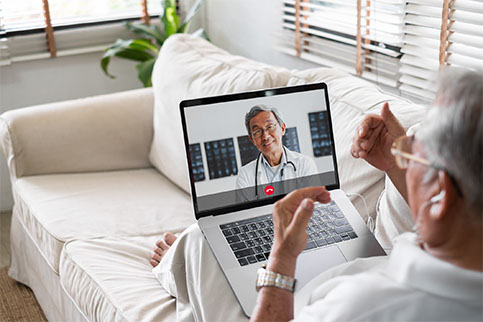Does inpatient care need to happen in the hospital? Using telehealth, remote monitoring, and mobile care teams, hospital-at-home programs deliver quality inpatient care in the comfort of one’s home.
Wesley, 74, is in the emergency room for the third time this year. His heart failure symptoms usually improve after a few days in the hospital, but he’s not going to stay this time. He hates leaving his wife, Flora, who struggles with depression, alone at home. And during his last hospitalization, he experienced a frightening bout of confusion and believed intruders were stalking the halls.
Now imagine Wesley’s surprise when the doctor suggests he be admitted—to his own bed at home. The physician explains the new hospital-at-home program to the family, who can barely believe their ears. Such an idea seems almost laughable! But Wesley definitely prefers to be at home with Flora and avoid the confusion and fear he experienced during his last visit.
An Urgent Need for Change in Patient Care
While our extant provider-centric paradigm has never been ideal for patients, the pandemic underscored its shortcomings. Many patients avoided healthcare settings during the initial lockdown. According to a survey by Harvard University, the Robert Wood Johnson Foundation, and National Public Radio, members of one in five U.S. households delayed or skipped care during this period. Over half of these individuals now report negative health consequences as a result.
In addition, the pandemic underscored shocking racial disparities in care quality and access. Black, Latino, and Indigenous patients contracted and died from COVID-19 at far higher rates than white patients. These trends illuminate a long shadow of medical neglect and limited access that now demands action from healthcare leaders.
And while the pandemic supercharged demand for patient-centric care, the need was always there. Wesley’s case is an illustrative example. About a third of hospitalized patients over 65 experience delirium, impacting their future health and functioning. Older inpatients also run the risks of hospital-acquired infections, functional decline, falls, and pressure injuries. And finally, hospitalization exacts a financial and social toll by keeping patients from work and family responsibilities (e.g., Wesley’s separation from his wife).
What’s emerging is demand for new care models that meet patients where they are. It’s time to extend care beyond the hospital walls—not only because recent events have exposed inequities in our system but also because it’s the right thing to do. To illustrate, let’s examine hospital at home in more detail.
Bringing the Hospital Home to Patients
Hospital-at-home programs deliver an inpatient level of care to patients in the community via telehealth, remote monitoring, and mobile care teams. They’re most appropriate for medium-acuity patients whose conditions have well-defined treatment protocols (e.g., COPD and CHF).
Hospitals at home are common in Canada, Australia, Israel, and the United Kingdom. A robust body of research shows they reduce costs while boosting outcomes and patient satisfaction. However, until recently, this approach never gained traction in the U.S. due to cultural and reimbursement barriers. Medicare has never recognized the home as a clinical site of care, and most states and private insurers have followed suit. Additionally, the hospital-at-home concept flies in the face of the provider-centric culture endemic to the U.S.
This changed during the pandemic, when hospital-at-home programs became top of mind. In 2020, Vituity partnered with Adventist Health Central Valley Network to open a 150-bed hospital at home in one of California’s most underserved regions. This program led to the adoption of the offering throughout the Adventist Health network. The Veterans Health Administration, Mayo Clinic, Kaiser Permanente, and other leading health systems have also invested in this concept.
Hospital at Home Benefits to Patients, Providers, and Hospitals
For patients, hospital at home represents quality of life. Given a choice, many of us would prefer to heal in the comfort of our homes with our loved ones nearby. Research shows hospital-at-home patients experience less delirium and receive fewer low-value lab and diagnostic tests. It’s no wonder recipients and families rate these programs highly on patient experience surveys.
Like patients, clinicians also report high levels of satisfaction with hospital at home. Hospitalists at Adventist enjoy spending more time with each patient and even having opportunities to address social determinants of health. For example, during a telehealth visit, a hospitalist might notice fall hazards in the home or a caregiver struggling with burnout. By connecting families with needed social resources, clinicians can often achieve better, more sustainable health outcomes.
Finally, health systems are reaping the many benefits of hospital at home. Research suggests that these programs perform equal or better on measures like mortality, lengths of stay, and clinical outcomes compared to traditional hospitals.8 In addition, they are very cost-effective to operate, with an average savings of about 25% across multiple studies.9 For hospitals, increased patient satisfaction scores and lower costs add up to superior value and competitive performance under value-based reimbursement schemes.
Accomplishing a Patient-Centric Shift in Delivery Models
A paradigm shift always brings both disruption and opportunity. Here are some practical steps hospitals can take to ease the implementation of hospital at home and other patient-centric care models.
First, remember that all change starts in the heart and mind. We must therefore begin by engaging our front-line stakeholders, the heart of clinical care. The medical staff, which represents the hospital’s closest connection to its patients, must be brought to the table as early as possible, potentially even contributing to strategy development. After all, they experience the gaps in care and witness the patient’s needs daily.
Second, partner with organizations to extend more rapidly and effectively to the patient. This includes partnering with trusted community organizations to help address the social needs of patients. Keep in mind that many minority patients may be skeptical of the healthcare system, and community organizations can be instrumental in bridging the cultural divide. However, also partner with tech, provider, and ancillary service organizations that can complement your offerings to narrow the financial and timeline hurdle.
Finally, for health in place to succeed, healthcare leaders must lobby state and federal policymakers to formally recognize the home as a clinical site of care. This means leveraging your personal connections as well as working within advocacy and industry associations. One resource is the Moving Health Home coalition, an alliance of health systems, service providers, home care agencies, and physician groups dedicated to advancing home-based care policy.
The time is now to drive necessary change that unleashes the shackled potential for improving care and decreasing cost. To expedite change, healthcare leaders can educate policymakers about the benefits of home- and community-based clinical models. We need to emphasize the potential value of this approach to both the patients (outcomes and experience) and the system (quality and cost savings).
Healthcare Leaders Can Impact Patient Care Across the Country
To the delight of Wesley and his family, the hospital-at-home program was everything the doctor promised. Nurses visited twice a day, and the hospitalist teleconferenced daily with the family. Surrounded by support and comfort, Wesley recovered quickly and was “discharged” in just three days.
As healthcare leaders, it’s within our power to extend this enhanced experience to thousands of patients across the country. To pave the way, we must lead a paradigm shift that will require us to rally clinicians, community leaders, policymakers, and patients—to name just a few. It won’t be easy, but it’s what our patients deserve.























